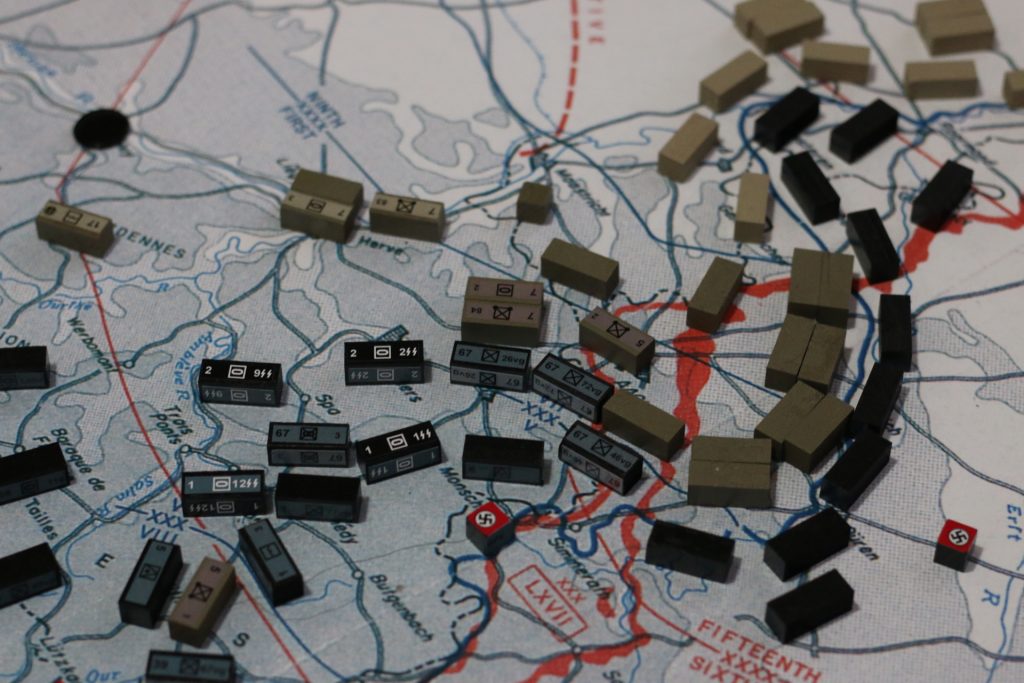I am designing the Pub Battles Borodino game. Having researched and prepared the preliminary order of battle, and then prepared all of the blocks I needed to begin working on the deployment of the Russian army, I made an interesting discovery.

As you may be aware, Pub Battles uses actual period maps of the battlefieldsas the game map. In the case of Borodino, we are using a French map which,I believe,is from the Atlas prepared to accompany the History du Consulat et de L’Empirepar,Volume 14 of which covers the battle of Borodino (published in Paris in 1856) by M. Adolphe Thiers.

As I was examiningthe source material and deploying the units on the period map, I was somewhat amazed (though in retrospect, I shouldn’t have been) by what the “game” was telling me. The period map shows that the area is fairly heavily wooded and is quite hilly and covered with dry streambeds (and consequently, stream banks). In some of the ‘hex and counter’ wargames covering the Battle of Borodino, the maps are fairly devoid of terrain, with many clear terrain hexes, and much of the wooded areas depicted on Adolphe Thiers’ period map missing.
While I was placing units on the map, it became apparent that in 1812, Kutuzov was using the terrain to his best advantage. Of course, his main line of defense is behind the Kalocza (also referred to as the Kalochka and other variants of the Russian spelling), which is a tributary of the Moskva River. However, there is an area in the center of the Russian line, where Kutuzov deployed a couple of Army Corps in a line perpendicular to the main line. Why there? Well, the period map answers the question; behind the small stream running south is an embankment, and the troops placed there are on the high ground just behind and overlooking the stream. When you look at the blank period map, you can’t help but notice the plateau (the village of Semenoffskoie is in the center of that “line” running north/south). So, Kutuzov deployed Russian units there in a sort of natural reverse “fishhook” for those familiar with the battle of Gettysburg. This position would allow the Russian troops deployed there to fire on the approaching French while they crossed the stream and climbed the embankments. Later, when Kutuzov realized that Napoleon was approaching his left flank and was not planning on an assault over the Kalocza, Kutuzov then extended his line to the left and had the Shevardino redoubt built and added to the Russian position on the extreme left; however, he left the two corps guarding the stream on the high ground in place.

Then, as I was working out the deployment of the Guard corps, I saw “The Old Fox” Kutuzov, using his cunning to deploy the guard in a wooded ravine, where they would be virtually undetectable by the French until they were moved out of reserve.
Kutuzov also deployed Karpov’s Cossacks where they would be hidden in the wooded terrain near Outitsa (also known as Utitsa). From what I have been able to learn, Tuchkov’s III corps was also deployed hidden ina wooded area not too far from Utitsa and the ‘Old Moscow Road.’(Determining the deployment of the III Corps on September 5th is a tricky undertaking). Kutuzov wrote to the Tsar about the trap he had laid with III Corps, which was hidden on the left flank, and which was to be sprung when and if Napoleon tried to outflank him on the left. Unfortunately for Kutuzov, another Russian commander, unaware of the ruse, repositioned III Corps closer to Outitsa and on open ground, without Kutuzov’s knowledge.

All of these things become readily apparent if you take the time to study the period map and look at how the Russian Army deployed for battle. Having been a wargamer for over 50 years now, I can tell you that often such things are not so apparent when looking at many other wargames. It seems that often, when maps are abstracted and “translated” onto a hex grid, much is lost in the translation from the source map to the game map. Because Pub Battles gives you the period map as the game map, no such abstraction takes place; you have the original source right there in front of you.
By: Charles F. Bryant, II





